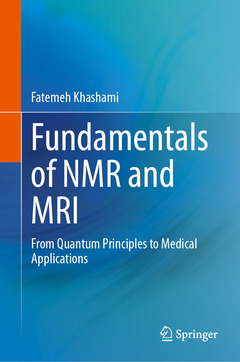Description
Fundamentals of NMR and MRI, 1st ed. 2024
From Quantum Principles to Medical Applications
Author: Khashami Fatemeh
Language: English
Subject for Fundamentals of NMR and MRI:
Approximative price 137.14 €
In Print (Delivery period: 15 days).
Add to cart223 p. · 15.5x23.5 cm · Hardback
Description
/li>Contents
/li>Biography
/li>Comment
/li>
This book bridges the gap between physical foundations and medical applications of the NMR and MRI technologies, making them accessible to both physicists and biomedical scientists. The physical basis of these technologies is discussed in a manner that can be easily understood by scientists from different backgrounds, aiding them in gaining a clearer understanding of the subject.. For instance, the medical applications of NMR and MRI technologies are described in a way that is accessible to physicists. Moreover, geometrical descriptions and specific mathematical tools are used to facilitate the visualizations of many concepts. Furthermore, the book covers modern technologies such as hyperpolarization and several other state-of-the-art techniques, along with their foundations.
2 Quantum
mechanics
2.1. Introduction to quantum theory
2.2. Elements of quantum formalism and Hilbert space
structure
2.3. Uncertainty relation between the two operators
2.4. Spin in quantum mechanics
2.5. The Stern-Gerlach experiment
2.6. Density matrix description
3 Physical basis
of NMR
3.1. Introduction
3.2. Zeeman effect in NMR
3.3. The Boltzmann distribution in NMR
3.4. The effect of magnetic field on spin populations at a
thermal equilibrium
4 The Bloch
equation description
4.1. Introduction to the Bloch equation
4.2. The Bloch equation without relaxation in the laboratory
frame
4.3. The Bloch equation without relaxation in the rotating
frame
4.4. Flip angle of the RF pulse
4.5. The Bloch equations with spin-lattice relaxation time
4.6. The Bloch equations with spin-spin relaxation time
4.7. The magnetization dynamics on the Bloch sphere
5. NMR spectroscopy and its properties
5.1. Introduction to NMR spectroscopy
5.2. Chemical shift
5.3. Electron shielding for organic chemicals
5.4. NMR sensitivity
5.5. Proton nuclear magnetic resonance spectroscopy
5.6. Carbon nuclear magnetic resonance spectroscopy
5.7. Phosphorus nuclear magnetic resonance spectroscopy
5.8. Nitrogen nuclear magnetic resonance spectroscopy
5.9. Fluorine nuclear magnetic resonance spectroscopy
5.10. Xenon nuclear magnetic resonance spectroscopy
6. Correlation rate
6.1. Introduction to correlation time
6.2. Tumbling rate of molecule
6.3. Dipole-dipole interaction
6.4. The Bloembergen-Pound-Purcell theory
6.5. Molecular motion on the relaxation time
6.6. The BPP theory and proton-proton interaction
6.7. The Solomon-Bloembergen-Morgan theory
7. FID signal
7.1. Introduction to NMR signal
7.2. The free induction decay (FID) signal
7.3. Spectral resolution
7.4. The Nyquist-Shannon sampling theorem
7.5. Fourier transformation
7.6. Insights from Heisenberg uncertainty principle
8. Foundations of MRI
8.1. Introduction to magnetic resonance imaging
8.2. Different parts of MRI scanner
8.3. Spin-echo pulse sequence
8.4. Gradient coils
8.5. Gradient echo pulse sequence
8.6. Gradient echo sampling
8.7. The signal-to-noise (SNR) ratio
8.8. Measure magnetization of MRI imaging
8.9. The mathematics behind the spatial encoding
8.10. Echo planar and spiral imaging
9. Consider some examples of relaxation and magnetization
behavior in MRI
9.1. Introduction
9.2. Consider relaxation and magnetization behavior in fat
and water molecules
9.3. Consider relaxation and magnetization behavior in brain
9.4. A summary of processing NMR and MRI experiment
10. MRI technology applications
10.1. Low field MRI applications
10.2. Gadolinium (Gd) application in MRI scan
10.3. Zeeman effect in hyperpolarized method
10.4. Hyperpolarized carbon MRI and its applications in
medical imaging
10.5. Hyperpolarized helium and xenon MRI and their
applications in medical imaging
Dr. Fatemeh Khashami attained her PhD from The University of Texas at Dallas, Department of Physics in 2021. Her dissertation was on Tracking the Biochemistry of Cancer Cells and Dynamics of Physical Systems Using Nuclear Magnetic Resonance. After completing her PhD she joined UT Southwestern Medical Center as a postdoc fellow researcher, where she works on various aspect of NMR and MRI application in medical sciences. Having a PhD in physics from one hand and working on biomedical science on the other hand, has led her to combine these two worlds and develop a particular vision to the NMR and MRI techniques.
Discussed the applications of NMR and MRI, including cutting-edge techniques such as hyperpolarization
Includes a brief intro to quantum mechanics and gradually moves toward the fundamentals of NMR and MRI
Targeted to both physicists and medical scientists who work on NMR and MRI technologies
These books may interest you

Annual Reports on NMR Spectroscopy 202.15 €

Annual Reports on NMR Spectroscopy 215.20 €


